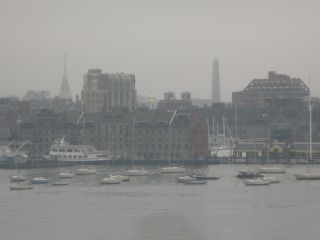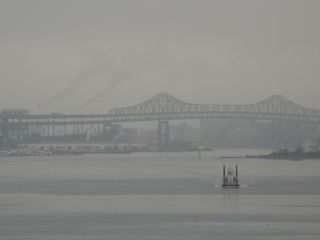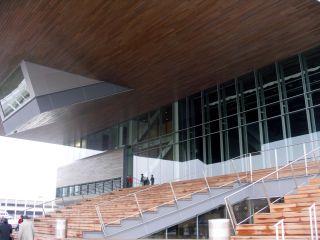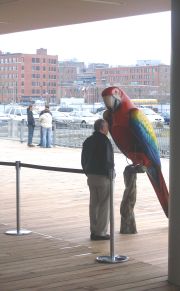December 28, 2006
Our New Museum
 "
"
View larger image of the harbor from the cantilever

View larger image of more of the harbor from the cantilever
At the risk of sounding like the harsh, judgmental, opinionated, behind-the-times, ludditful judge of taste and beauty that I am, and publicly displaying my lack of understanding and sophistication, I was really disappointed by the new Institute of Contemporary Art. To give the building its due, it does have an astonishing view of Boston Harbor -- a public perch from which to enjoy a semi-aerial peek at of the vista.
One approaches the ICA from its unflattering behind, through a maze of parking lots. Next door is the rather handsome Boston Fish Exchange, a brick building with arches. To the right of the Fish Exchange is a pale institutional green and yellow corrugated metal, four-story housetrailer, which looks to be perfectly sited in a warehouse/trailer park district. Thus began the cascade of disappointment.
On the ICA's opening day, the front page of the Globe had a shot of its much-touted teak cantilever which reaches over the harbor, leading the naive to assume that it was sculpted like the bow of a ship. The truth is that a photographer who is unwilling to charter a vessel can't get far enough back on the ground to shoot the building without taking a dip. Thus the teak cantilever gets photographically distorted. It's much better distorted. In reality, the teak cantilever is a flat box with a window in it.
There is teak everywhere. On the massive deck and all the way up the Mayan Temple stairs. Teak, left in it's natural state, unevenly aged, and, when wet, very blotchy. The rainforest weeps.

View larger image of the front of the place
One enters a large lobby, currently dominated by a Japanese cartoon mural on the Sandra and Gerald Fineberg Art Wall, which is a peculiar shape - a rectangle with one rounded corner. We are informed that a "site specific" work of art will be commissioned yearly to fill the space. The shape guarantees that an artist can't submit any old canvas s/he has lying around.
Behind the mural, the State Street Corporation Lobby was vast and cold, dominated by a glass freight elevator. After purchasing one's admission ticket ($12, $10 for seniors and students), it is far from obvious what one must do next in order to see some art. The gift shop and the "Water Cafe" are the only spaces that are visible. In fact, it is quite unlikely that one would find the galleries on one's own. They are on the fourth floor -- an opportunity to ride in the glass freight elevator, just in case you've never been to a Marriott Hotel. There didn't seem to be a name attached to the elevator. It is also unclear whether the space inside is available for parties.
All the art, not counting architecture or performance, is on the fourth floor, interesting and well displayed, certainly worth a visit. The cantilever window is accessible from the fourth floor galleries.
Any walls suitable for hanging can also be found on the fourth floor, since most of the front and sides of the building itself are glass. If I were designing a museum, I might make some or all of the exterior walls opaque, so that paintings could be hung on them, but I'm not. Even the 325 seat Barbara Lee Family Foundation Theater has three glass walls, two stories high, which must make anything theatrical, like showing films, quite a challenge Perhaps I missed the hydraulic black curtains that descend from the two story ceiling for darkening purposes. There are no wings or backstage, or anything that might come in handy for a conventional performance -- simply a flat stage upon which a sit-down dinner for 180 can be hosted. First things first.
Speaking of dinner, a visit to the Water Cafe, by Wolfgang Puck, which is as cozy as a prison cell in Siberia, (although it might be nice in the summer) was made even more unpleasant by really; really, really squashed seating and inefficient service. My coffee was burned, but at least that isn't a permanent architectural feature.
The gift shop went unexplored, due to corporate overload. It doesn't seem to be online yet.

View image from the inside of the cantilever
Perhaps I had better attend the Diller, Scofidio + Renfro Lecture "Unimpaired Vision", to deepen my appreciation.
Things I learned from artists over the holiday
. Museums are dependent on private and corporate donors. That's why the newer architecture is so weird -- donors want spaces upon which they can hang brass plaques and the architects must accomodate
. Architects, while working around all the requirements of the board of directors and the major donors, often design a space that looks like it was done by committee. Of course, the architects must put thier own mark on the building, and voila, you have something llke our new museum, ongepatshket, as they say in Yiddish.
. There's a difference between an artist and a hobbyist
. If you see it in a museum, it's art. If you see it by the side of the road, it's kitch.

View larger image of the parrot on the teak deck with a phonebooth in its belly
Photo notes: Included in the text
Posted by Dakota at December 28, 2006 06:18 AM